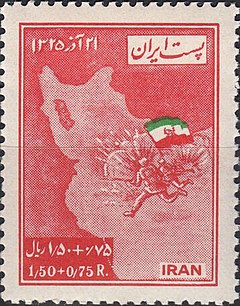| Iran crisis of 1946 | |||||||
|---|---|---|---|---|---|---|---|
| Part of the aftermath of the Second World War, the Cold War and Kurdish separatism in Iran | |||||||
 Iranian postage stamp commemorating the fourth anniversary of the liberation of Azerbaijan | |||||||
| |||||||
| Belligerents | |||||||
|
Supported by: |
Supported by: | ||||||
| Commanders and leaders | |||||||
|
|
| ||||||
| Units involved | |||||||
| Imperial Iranian Army |
Azeri militias Kurdish tribes[1] | ||||||
| Strength | |||||||
| Unknown | 12,750 Peshmerga infantry and cavalry[1] | ||||||
| Casualties and losses | |||||||
| Hundreds killed (per Kurdish reports) | Unknown | ||||||
| 2,000 killed in total[4] | |||||||
The Iran crisis of 1946, also known as the Azerbaijan Crisis (Persian: غائلهٔ آذربایجان, romanized: Qā'ele-ye Āzarbāyejān) in Iranian sources, was one of the first crises of the Cold War, sparked by the refusal of Joseph Stalin's Soviet Union to relinquish occupied Iranian territory despite repeated assurances. The end of World War II should have resulted in the end of the Allied joint occupation of Iran. Instead, pro-Soviet Iranians proclaimed the separatist Azerbaijan People's Government[5] and the Kurdish separatist Republic of Mahabad. The United States pressure on the Soviet Union to withdraw is the earliest evidence of success with the new strategy of Truman Doctrine and containment.
In August–September 1941, Pahlavi Iran had been jointly invaded and occupied by the Allied powers of the Soviet Red Army in the north and by the British in the centre and south.[6] Iran was used by the Americans and the British as a transportation route to provide vital supplies to the Soviet Union's war efforts.[6]
In the aftermath of the occupation of Iran, those Allied forces agreed to withdraw from Iran within six months after the cessation of hostilities.[6] However, when this deadline came in early 1946, the Soviets, under Joseph Stalin, remained in Iran. Soon, the alliance of the Kurdish and People's Azerbaijani forces, supported in arms and training by the Soviet Union, engaged in fighting with Iranian forces,[1] resulting in a total of 2,000 casualties. Negotiation by Iranian premier Ahmad Qavam and diplomatic pressure on the Soviets by the United States eventually led to Soviet withdrawal and dissolution of the separatist Azeri and Kurdish states.
- ^ a b c d e f g Lortz, Michael G. "Introduction". The Kurdish Warrior Tradition and the Importance of the Peshmerga (PDF). pp. 27–29. Archived from the original (PDF) on October 29, 2013. Retrieved October 16, 2014.
- ^ Miyata, Osamu (July 1987), "The Tudeh Military Network during the Oil Nationalization Period", Middle Eastern Studies, 23 (3): 313–328, doi:10.1080/00263208708700709, JSTOR 4283187
- ^ Ahmadoghlu, Ramin (2019), "Azerbaijani National Identity in Iran, 1921–1946: Roots, Development, and Limits", The Journal of the Middle East and Africa, 10 (3): 253–278, doi:10.1080/21520844.2019.1656455, S2CID 204368556
- ^ "CSP – Major Episodes of Political Violence, 1946–2012". Archived from the original on January 21, 2014. Retrieved November 14, 2013.
- ^ All the Shah's Men, Kinzer, p.65-66
- ^ a b c Sebestyen, Victor (2014). 1946: The Making of the Modern World. Pan Macmillan. ISBN 978-0230758001.